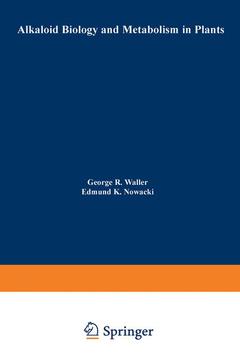Alkaloid Biology and Metabolism in Plants, Softcover reprint of the original 1st ed. 1978
Langue : Anglais
Auteur : Waller G.

* This book is designed for the use of the advanced student and professional worker interested in the international scientific community, particularly those in the fields of agronomy, agricultural sciences, botany, biological sciences, natural products chemistry, pharmaceutical chemistry and bio chemistry. The purpose is to inform the reader about significant advances in the biology and metabolism of alkaloids in plants. Since alkaloids are generally referred to as "secondary metabolites," the reactions discussed are not, for the most part, involved with the main metabolic pathways. The reactions that we are interested in are pathways that have been developed for the formation of these secondary metabolites, using as their starting mole cules one of the compounds produced via a main or primary metabolic path way. The primary metabolic pathways are common to all plants, indeed to most living organisms, whereas the highly specialized branches leading to alkaloid formation are found in only about 10 to 20 % of the known plants. The reason for these diversities in plant metabolism is not clear; however, it seems likely that the formation of highly individualized and specialized pathways resulted as a response to the pressure of natural selection. Nevertheless, the genetic peculiarity that controls alkaloid production has provided many extremely interesting problems for scientists and consti tutes convincing evidence of nature's superior ability in biochemistry.
1. Alkaloids in Chemotaxonomic Relationships.- 1.1. Introduction.- 1.2. Taxonomic Character of Alkaloids.- 1.3. Conclusion.- 2. Genetic Control of Alkaloid Production.- 2.1. One Gene, One Enzyme, One Reaction Hypothesis.- 2.2. Alkaloid-Rich and Alkaloid-Poor Plants within a Species: The Inheritance Pattern.- 2.3. The Inheritance Patterns of Individual Alkaloids.- 2.4. Intraspecific and Interspecific Hybridization.- 2.5. The Inheritance of Ability to Store Alkaloids of Different Oxidation Levels.- 2.5.1. The Tropane Alkaloids.- 2.5.2. The Quinolizidine Alkaloids.- 2.6. Inheritance of the Ability to Store O-Methylated Alkaloids.- 2.7. Inheritance Pattern for Nitrogen Methylation.- 2.8. Inheritance Patterns Related to the Complexity of the Molecular Formula.- 2.9. Conclusions.- 3. Environmental Influences on Alkaloid Production.- 3.1. Introduction.- 3.2. The Influence of Light, Water, and General Climatic Conditions.- 3.3. Nitrogen, Potassium, and Other Mineral Nutrients.- 3.4. External Influences.- 3.5. Conclusion.- 4. Sites of Alkaloid Formation.- 4.1. Introduction.- 4.2. Solanaceae Alkaloids.- 4.3. Lupine Alkaloids..- 4.4. Papaveraceae Alkaloids.- 4.5. Ricinine in Ricinus communis.- 4.6. Other Plants.- 4.7. Alkaloid Accumulation in Seeds.- 4.8. Conclusions.- 5. The Role of Alkaloids in Plants.- 5.1. Introduction.- 5.2. Alkaloids as Growth Stimulators and Inhibitors.- 5.3. Alkaloids as Plant-Protecting Compounds.- 5.4. Protection against Fungi and Bacteria.- 5.5. Alkaloids and Virus Resistance.- 5.6. Plant-Insect Coevolution: The Role of Alkaloids.- 5.7. Alkaloids and Herbivorous Vertebrates.- 5.8. Other Roles of Alkaloids.- 5.9. Conclusion.- 6. Metabolic (Catabolic) Modifications of Alkaloids by Plants.- 6.1. Introduction.- 6.2. Methods Used to Study Secondary Metabolism of Alkaloids.- 6.3. Evidence for Metabolism or Catabolism.- 6.4. Diurnal and Developmental Variations.- 6.5. Turnover Rates.- 6.6. Demethylation.- 6.6.1. Relation between Methylation and Demethylation and Their Biological Significances.- 6.6.2. N-Demethylation of Nicotine.- 6.6.3. N-Demethylation of Ricinine.- 6.6.4. O-Demethylation of Ricinine.- 6.6.5. Possible Physiologic or Metabolic Significance of Ricinine, N-Demethylricinine, and O-De-methylricinine.- 6.6.6. N-Demethylation of Hyoscyamine.- 6.6.7. Demethylation of Hordenine.- 6.6.8. Demethylation of Caffeine.- 6.7. More Extensive Degradation of Alkaloids and Introduction of Their Catabolites into Primary Metabolic Pathways.- 6.7.1. Nicotine and Other Tobacco Alkaloids.- 6.7.2. Specific Metabolites of Nicotine.- 6.7.3. Ricinine.- 6.7.4. Degradation of Alkaloids to Other Alkaloidal Compounds.- 6.7.5. Degradation of Steroid Alkaloids.- 6.7.6. Hordenine.- 6.7.7. Conversion of Gramine into Tryptophan.- 6.7.8. Caffeine.- 6.7.9. Morphine.- 6.8. Subcellular Localization of Alkaloids.- 6.9. Bound Forms of Alkaloids.- 6.9.1. Coniine and ?-Coniceine.- 6.9.2. Morphine and Related Alkaloids.- 6.10. Regulation of Metabolic Pathways.- 6.11. Use of the Metabolic Grid to Explain the Metabolism of Ricinine in Ricinus communis and Quinolizidine Alkaloids in Leguminosae.- 6.12. Summary.- References.- Author Index.
Date de parution : 02-2012
Ouvrage de 294 p.
15.2x22.9 cm
Disponible chez l'éditeur (délai d'approvisionnement : 15 jours).
Prix indicatif 105,49 €
Ajouter au panierThème d’Alkaloid Biology and Metabolism in Plants :
Mots-clés :
agriculture; agronomy; alkaloids; biology; botanics; metabolism; natural product; plant; plant metabolism; plants
© 2024 LAVOISIER S.A.S.



